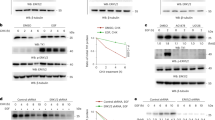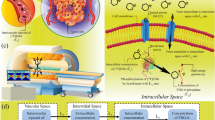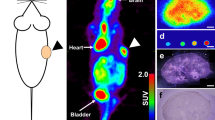Abstract
This animal study investigates the application of positron emission tomography (PET) with tracers of tumour metabolism for monitoring suicide gene therapy with herpes simplex virus thymidine kinase (HSVtk). After transplantation of HSVtk-expressing Morris hepatoma cells into ACI rats, dynamic PET measurements of 18F-labeled 2-fluoro-2-deoxyglucose (FDG) uptake were performed in animals 2 days (n = 7) and 4 days (n = 5) after the onset of therapy with 100 mg ganciclovir (GCV)/kg body weight as well as after administration of sodium chloride (n = 8). The arterial FDG plasma concentration was measured dynamically in an extracorporeal loop and the rate constants for FDG transport (K1, k2) and FDG phosphorylation (k3) were calculated using a three-compartment model modified for heterogeneous tissues. Also, quantification using the metabolic rate of FDG turnover and the standardized uptake value (SUV) was done. Furthermore, the thymidine incor- poration into the tumour DNA was determined after i.v. administration of 3H-thymidine. An uncoupling of FDG transport and phosphorylation was found with enhanced K1 and k2 values and a normal k3 after 2 days of GCV treatment. The increase in FDG transport normalized after 4 days whereas the phosphorylation rate k3 increased. Quantification using the metabolic rate or the SUV showed congruent but less sensitive results compared with the modeling approach. The thymidine incorporation into the DNA of the tumours declined to 10.5% of the controls after 4 days of GCV treatment. The data indicate that PET with 18FDG and 11C-thymidine may be applied for monitoring of gene therapy with the HSVtk/GCV suicide system. Increased transport rates are evidence of stress reactions early after therapy. The measurement of thymidine incorporation into the tumour DNA can be used as an indicator of therapy efficacy.
This is a preview of subscription content, access via your institution
Access options
Subscribe to this journal
Receive 6 print issues and online access
$259.00 per year
only $43.17 per issue
Buy this article
- Purchase on SpringerLink
- Instant access to full article PDF
Prices may be subject to local taxes which are calculated during checkout
Similar content being viewed by others
Author information
Authors and Affiliations
Rights and permissions
About this article
Cite this article
Haberkorn, U., Bellemann, M., Gerlach, L. et al. Uncoupling of 2-fluoro-2-deoxyglucose transport and phosphorylation in rat hepatoma during gene therapy with HSV thymidine kinase. Gene Ther 5, 880–887 (1998). https://doi.org/10.1038/sj.gt.3300679
Received:
Revised:
Accepted:
Published:
Issue date:
DOI: https://doi.org/10.1038/sj.gt.3300679
Keywords
This article is cited by
-
Molecular imaging of tumor metabolism and apoptosis
Oncogene (2011)
-
[18F]FLT PET for Non-Invasive Monitoring of Early Response to Gene Therapy in Experimental Gliomas
Molecular Imaging and Biology (2011)
-
Evaluation of tumor growth in vivo in a rat model of liver metastasis, using a newly devised index obtained by positron emission tomography with [18F] FDG
Journal of Hepato-Biliary-Pancreatic Surgery (2007)
-
Changes in glucose metabolism and gene expression after transfer of anti-angiogenic genes in rat hepatoma
European Journal of Nuclear Medicine and Molecular Imaging (2007)
-
Imaging progress of herpes simplex virus type 1 thymidine kinase suicide gene therapy in living subjects with positron emission tomography
Cancer Gene Therapy (2005)



